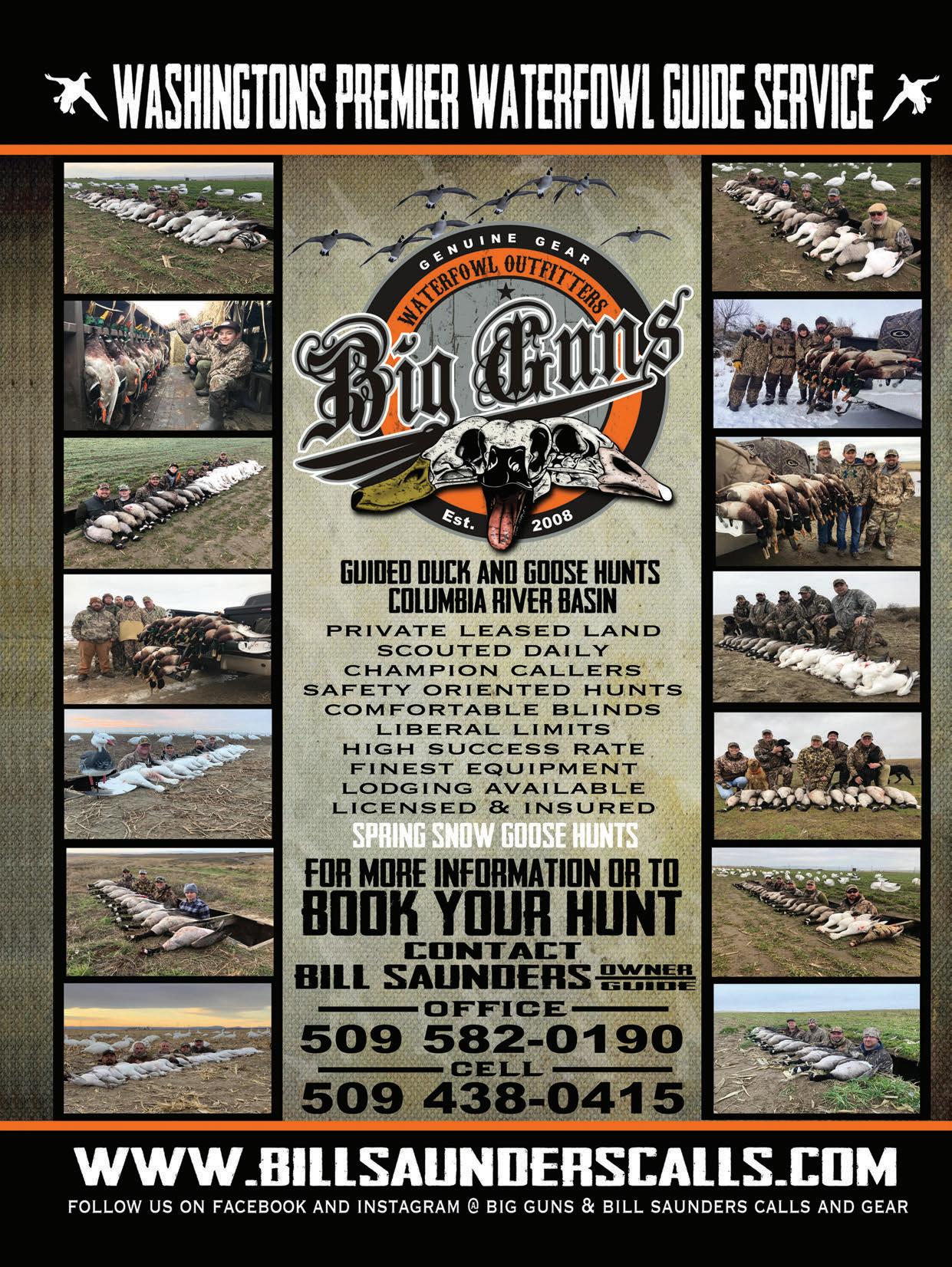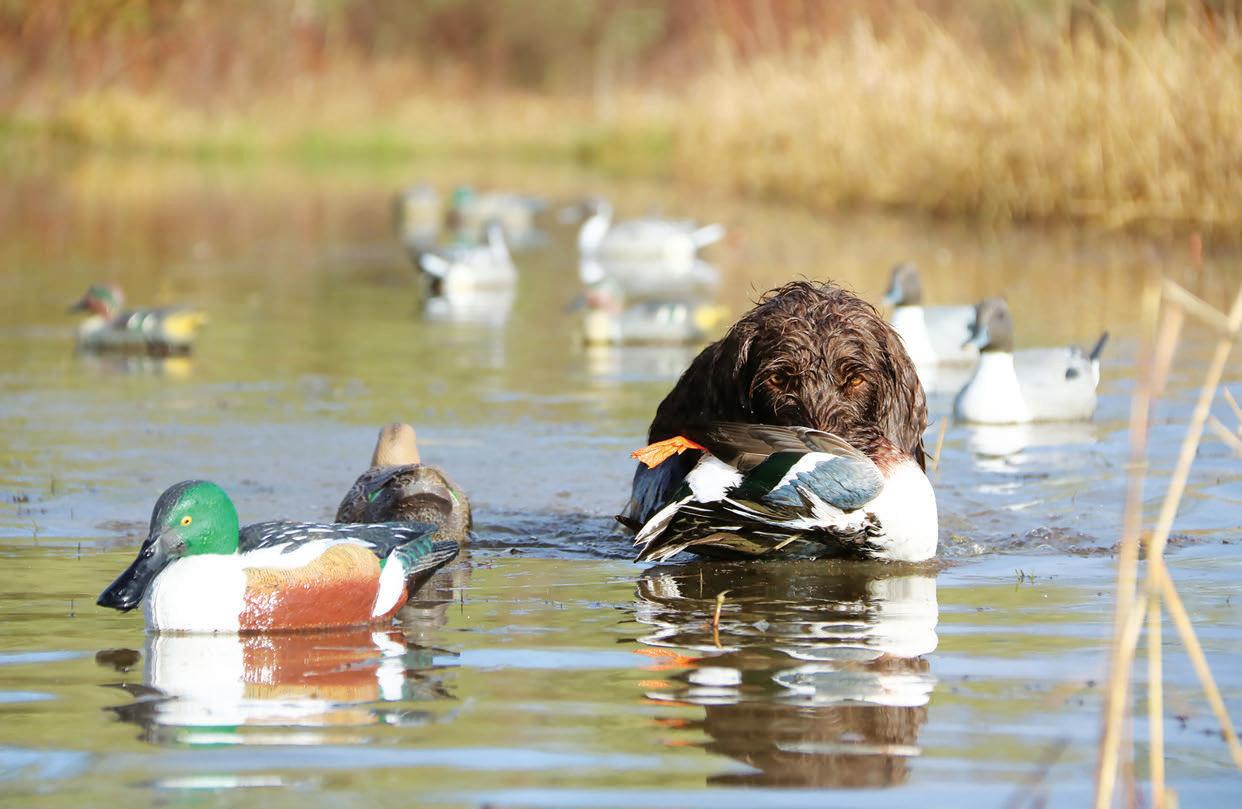
15 minute read
Creek winter-run Chinook From Field to Fire: Caring for your waterfowl decoys
FROM FIELD...
Adding contrasting white and black colors to your waterfowl decoy spread helps attract the attention of distant, often wary birds. (SCOTT HAUGEN)
THE CARE & FEEDING OF DECOYS HOW TO MAKE YOUR FAUX FLOCK LAST LONGER AND BE MORE PRODUCTIVE
By Scott Haugen
Waterfowl season is here; we just need some water and birds to move in. In preparation for the prime part of the season, here are some things to consider when it comes to decoy use and preparation.
DECOY CARE Duck and goose decoys have come a long way since I first started using them in the early 1970s. With the attention to detail, anatomy and paint jobs that make decoys mimic the real thing, keeping them looking that way is important.
Not only will taking proper care of your decoys extend their life, it will also attract more birds. At the end of the day, give your decoys a quick rinse of fresh water. Get saltwater, weeds, grass and seeds off the decoys to ensure they don’t dry on the decoy, and then peel off paint when you go to pick them clean.
If the decoys have mud or clay on them, use dish soap and hot water to get them clean. It’s important to get mud off the dark parts of decoys, as it can dry light in color and make it appear unnatural.
For those pricey decoys with special head finishes, getting a decoy bag with individual slots will keep
... TO FIRE
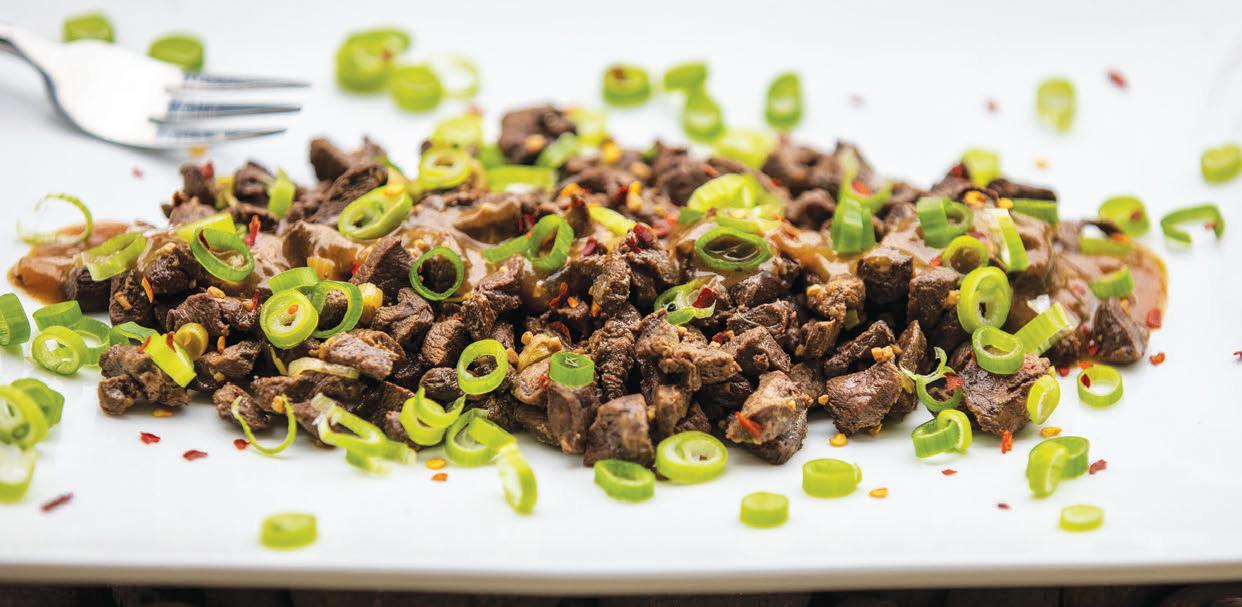
They may not sound appetizing to some, but among the best parts of a harvested duck are its heart and gizzard. And Tiffany Haugen has a delicious Asian-infused recipe to go make good use of your bird. (TIFFANY HAUGEN)
A DUCK DISH WITH HEART (AND GIZZARD)
By Tiffany Haugen
The gizzard is among the healthiest and most nutritious parts of a game bird, yet it is among the most neglected when it comes to table fare. Full of protein, low in fat and carb-free, once the silver skin and grinding plates are removed from a gizzard, it’s a firm, clean cut of meat.
Bird hearts are also a tasty, healthy treat. High in protein, riboflavin, iron, zinc and vitamin B12, we like cutting out the large arteries and fat surrounding the upper heart prior to cooking.
Whether cooked alone or chopped up with other parts of your bird, here’s a tasty recipe that makes a great topper for your salad, rice or pasta, or it can be enjoyed as is. If you want to save a bunch of gizzards and hearts from small game birds and ducks to cook all together, this recipe is great for that, too. This recipe works with any game bird. We used duck in this sample.

1 pound thinly sliced duck meat (heart, gizzard, breast, thigh and/or back) ¼ cup soy sauce 2 tablespoons sesame oil 2 tablespoons honey 2 tablespoons olive oil 1 tablespoon minced garlic 1 tablespoon gochujang or chili sauce One or two green onions 1 teaspoon cornstarch 1 tablespoon cold water
Thinly slice duck meat. Thinly slice green onion, separating the white bottoms (to put in the marinade) from the green tops (to use as a garnish). In a medium bowl, mix onions, soy sauce, honey, oil, garlic and chili sauce until thoroughly combined. Place meat in marinade and let sit at room temperature 20 to 30 minutes. For longer marinade times – up to four hours – refrigerate until ready to cook.
Heat a large skillet on medium-high heat. Add meat and marinade to the skillet and stir-fry until meat reaches desired doneness. Keep this in mind: The longer duck cooks, the stronger the flavors and tougher the meat may become. Remove meat from skillet and set aside. In a small bowl, mix cornstarch with cold water. Add to the skillet and bring sauce to a boil, stirring constantly for about a minute. Serve sauce over duck or add duck back into the sauce before serving. Garnish with remaining green onion.
Editor’s note: For signed copies of Tiffany Haugen's popular cookbook, Cooking Game Birds, send a check for $20 to Haugen Enterprises, P.O. Box 275, Walterville, OR 97489, or visit scotthaugen.com for this and other titles.

High-end decoys, like these from Dave Smith Decoys, are not cheap. In order to maximize their effectiveness and your investment, storing and transporting them in slotted bags is ideal. (SCOTT HAUGEN)

them from coming into contact with one another, which quickly ruins paint jobs and flocking finishes.
When home, avoid tossing bags of loose decoys atop one another, as that causes wear and ruins paint jobs. Storing decoys in slotted bags is ideal. You can also hang them up in Texas rig decoy bags, or Texas rigs alone. Decoys can get costly, and investing just a little time in how you carry and store them will prolong their life and performance.
BRING ON THE BLING Color is one of the most important features of a duck decoy spread. While it’s true that movement and position are critical, if decoys can’t easily be seen their full benefit goes neglected.
The two colors most visible on a decoy are white and black. This is because they create contrast amidst a range of lighting conditions. Be it sunny days, overcast days or rainy days, black and white decoys nicely compliment one another.
When hunting puddle ducks, drake pintail and shoveler decoys offer high-visibility white to your mallard, teal and wigeon spreads. Adding a few Canada goose decoys will not only provide confidence to a duck spread, but the white patches on these larger decoys are eye-catching from afar.
When positioning white-colored puddle duck decoys in the marsh, try spreading them throughout the flock so the direction they’re facing or moving in the wind is optimized and reflects incoming light.
When fastening diving duck decoys to a string, try placing the white ones furthest from where you’re shooting, as this will often catch the attention of birds, which then encourages them to bank closer to the dark decoys.
I know of many diving duck hunters who paint nearly all their decoys white to capitalize on light reflection. Others might use all black decoys when targeting species like scoters.
The ratio of white to dark duck decoys you have in a spread will come down to personal preference, lighting conditions and the species being hunted. Don’t be afraid to go heavy on white-colored decoys, even if it means investing in species of decoys you’re not targeting.
CONFIDENCE DECOYS Herons, egrets, coots, Canada geese and swans have one thing in common: they can help bring more ducks into your decoy spread. Why? Because these birds are wary, have exceptional eyesight and frequent the same water used by many duck species.
Waterfowl and other shore birds have a symbiotic relationship; this is
where one species benefits another, and vice versa. In many cases ducks stir up feed that attracts other shore birds, and in turn these fellow keen-eyed sentries alert waterfowl of danger that might otherwise go undetected.
The key to finding what confidence decoy is right for you comes down to seeing what species are in your hunting area. Keep in mind that which species of confidence decoy you use can change throughout the season as birds migrate through.
Now is the time to start preparing those waterfowl decoys, for once the season starts you want everything in order so you can focus on the hunt. CS
Editor’s note: For signed copies of Scott Haugen’s popular DVD, Field Dressing, Skinning & Caping Big Game, send a check for $20 (FREE S&H) to Haugen Enterprises, P.O. Box 275, Walterville, OR 97489, or order online at scotthaugen.com.
This season, try adding multiple species of ducks to your decoy spread, making sure to include contrasting colors. (SCOTT HAUGEN)



WATERFOWLING SETUP GUIDE THERE’S MUCH MORE TO BRINGING DUCKS IN THAN JUST TOSSING OUT A DOZEN DECOYS.
By Art Isberg
Golden State waterfowl hunters truly do have one of the finest and largest choices of both state and federal public shooting refuges available anywhere in the entire nation. The list, from north to south, reads like a geographical “who’s

who” in the waterfowling fraternity.
Beginning with the far north near the Oregon border, there’s Shasta Valley, then Tule Lake; at midstate, Sacramento, Delevan and Grizzly Island; and locations further south include Kern, Merced and San Luis. All are tremendously popular destinations.
California is also unique to other states in another very big way – mostly because of its vast north/ south landmass that stretches nearly 1,000 miles corner to corner. That means that during fall and winter weather, you can have rainstorms in the north at the same time that the south basks in warm sunshine. This is
California’s fertile waterfowl hunting habitat provides plenty of chances to have success this winter. Here, author Art Isberg retrieves a pair of green-winged teal that worked his decoy spread. (ART ISBERG)
Green-winged teal are important birds for Pacific Flyway shooters. Their decoys should be part of hunters’ regular layouts. (ART ISBERG)

also important to understand because fall waterfowl migration down the Pacific Flyway can be very different as to species, their presence and the numbers in differing parts of the state.
To put it another way: Not all mallards, pintail, teal, wigeon or gadwall arrive at the same time in the same place. Realistic decoy layouts should clearly reflect this for top gunning success.
GREEN-WINGED TEAL Green-winged teal are early fall migrants both in Northern and Central California. The little speedsters arrive in numbers before larger birds like wigeon, mallards and pintail do.
Because of their timing, they make up larger numbers in hunters’ bags throughout the first half of the season. Any savvy shotgunner would be wise to float a dozen green-winged teal decoys along with his regular larger blocks layout.
Floating all pintail or all mallard decoys when neither bird has moved in numbers into the area you’re hunting simply makes for an unnatural-looking spread. As gunning pressure increases, naturallooking layouts of current local bird species always work best, compared to more suspicious shot-over birds. That’s what decoy rigs should show.
I like to set my teal decoys on either the outside edge or the downwind portion of my regular layout where they are out in the open – and easiest to see – rather than lost in larger decoys at the center. Mixing teal decoys in with mallard or pintail like this means I’m generally floating three or four dozen total blocks.
Teal are quick to decoy to floaters of their own kind. I’ll still set teal decoys in my overall spread even late in the season. They break up that wooden soldier look of all decoys exactly the same shape and size.
To add to this natural look, I’ll tailtie a third of my teal decoys – as I do larger blocks – so they’re not all facing one direction and are easier moved by wind or current. It adds another nice touch that makes any overall decoy layout look real. The little teal really top off a setup like this.
WIGEON Wigeon are the second most harvested duck species, filling a lot of Pacific Flyway hunters’ bags, and doing so early in the season, like teal. Yet for some strange reason, few hunters own or float wigeon decoys in their regular sets.
I’ve never understood why. Like teal, wigeon will readily work to decoys of other species, but their addition to your mallard or pintail layouts, along with teal, really does a solid job of matching natural bird gatherings in your area. Go to any nearby refuge area to see what I mean by this mix. I like to set a dozen wigeon to a dozen greenheads or bull sprig, plus the teal. At some time in the season, depending on where I’m hunting, I’ve floated a set consisting of only wigeon and teal decoys, because that area held very few larger birds. I’ve never suffered a slow day’s gunning because of it. As a pair, they complement each other.
I keep two dozen flashy wigeon
decoys in my decoy stash, using them in various numbers as season advances, and bird numbers change. Their colorful body patterns – that white front face and fancy sidebars – really add a nice touch of color and a different size and shape to any decoy layout, regardless of size. And I like to tail-tie three or four decoys in a dozen so they move by weather in a different direction, imitating busy feeders.
PINTAIL The graceful and wary pintail sprig is the second most popular and coveted bird in the Pacific Flyway – trailing only the mallard in the pecking order. Some dedicated sprig hunters might argue that point. By definition, the pins are late-season arrivals throughout California.
It’s also quite common to see small bunches of green-winged teal flying in flocks of pintails. That tells us that
Isberg makes good use of his decoy barge when he loads it with decoys, birds and guns. It’s a perfect setup for a waterfowler. (ART ISBERG)
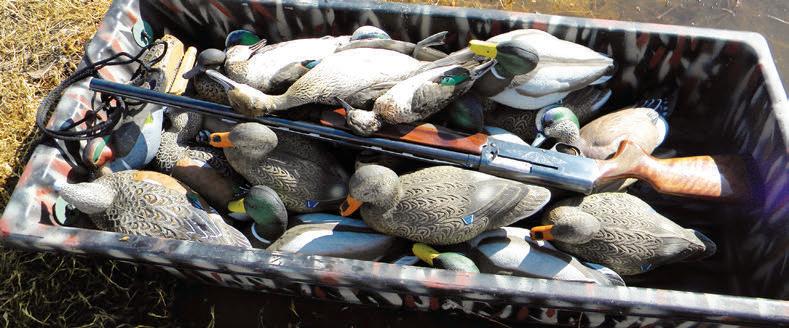


Confidence decoys like this heron can add a nice touch of realism to any layout. (ART ISBERG)
A decoy barge like this one Isberg owns gives hunters an easy way to haul lots of decoys without backaches. (ART ISBERG)
on the water, the two species mix well and your decoy rigs should match that.
Due to their inborn wariness, pintail respond best to large decoy spreads. In the pintail marsh I grew up hunting, private clubs thought little of floating 100 sprig decoys to each set of double blinds, trying to convince the birds to drop in by a show of sheer numbers.
Because most day shooters in refuge areas cannot match numbers like this, wise ’gunners need a way to haul big spreads without backaches.
The answer is using little “decoy barges,” which are small plastic floats generally 5 feet long by about 3 feet wide. A single barge can hold more decoys than one man can carry on his back. Four dozen of them fit nicely inside. Hunting with a buddy, as most of us do, you can double the number of your layout. I also add my gun,

Along with decoys imitating multiple species, the author carries a variety of calls for a day in the field. (ART ISBERG)
shells and something to eat or drink in my barge.
These slick little neoprene plastic floats slide easily over mud, snow, ice and even dry ground. They can be towed behind ATVs to hunting areas. I hook a short line from my barge to the belt on my waders and move hands-free in the water or out. If I want to use a wading staff or flashlight, my hands are free to do so.
Once set up to hunt, the darkcolored or camo-colored floats can be turned over to blend in with weeds, grass or tules.
The barges have really changed the face of waterfowl hunting since their inception. I never go hunting without mine in tow.
MALLARD Big, gaudy, loud-calling mallards are the number one choice of California waterfowl hunters, as they are throughout the nation. They respond well to authentic calling and will decoy to a puddle the size of a wash tub – or, just as quickly, a large lake and reservoir.
You can have gunning success floating a half-dozen decoys in a hidden tule-lined pothole, or you can have four dozen riding the current on a bend in the river. Indeed, the mallard’s strong point is its diversity.
Regardless of where I’m hunting these big birds – public shooting grounds or freelancing on my own in an open marsh – I rely on one important point to convince them in. I prefer to use magnum-sized decoys. I do this for several important reasons. First, the big jumbos can be easier seen in low light, cloudy days and in surrounding cover. Their flashy colors and size work real magic. I have one set of mallard floaters that are actually goose decoys painted in mallard colors and mallard heads. On these points, size does matter!
Another advantage for the big boys comes when you’re hunting public areas, which can be either state or federal land. Like it or not, public
hunting means you will be competing with dozens of other shooters and their decoys, sometimes set up nearby.
You want your decoy layout to draw in circling birds to you, passing up all the other hunters’ setups. What catches their attention? Size and color. I believe two dozen magnum decoys have more drawing power than twice that number in standard-sized decoys. I’ve relied on that power for decades.
WATERFOWL WONDERLAND As California hunters graced by winged travelers of the Pacific Flyway, we are given a unique opportunity to experience the finest public hunting anywhere.
Understanding the many species of high-flying waterfowl that visit us each fall and winter, plus what decoy choices bring us gunning success, is the backbone of our sport.
Decade after decade, they give us ’gunning memories to last a lifetime. CS



A couple dozen freshly painted decoys like this set of pintails and mallards can produce great waterfowling in the Golden State. (ART ISBERG)
Also Available: Hunts in Saskatchewan, Canada! • Mallard Corn Pond Hunting on 16 Private Ponds • Freeze Up No Problem! Aerators & Springs in Most Ponds Average 5.5 Ducks Per Person in the 2019-20 Season!!
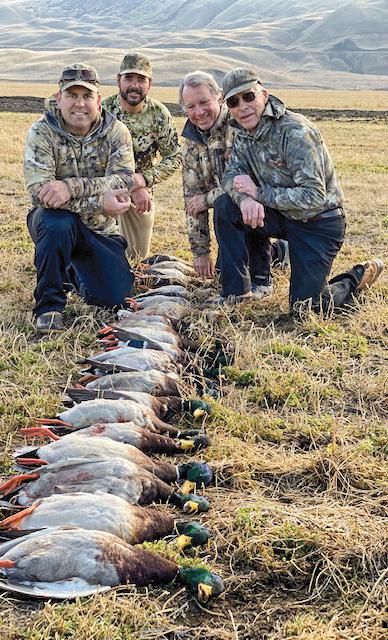
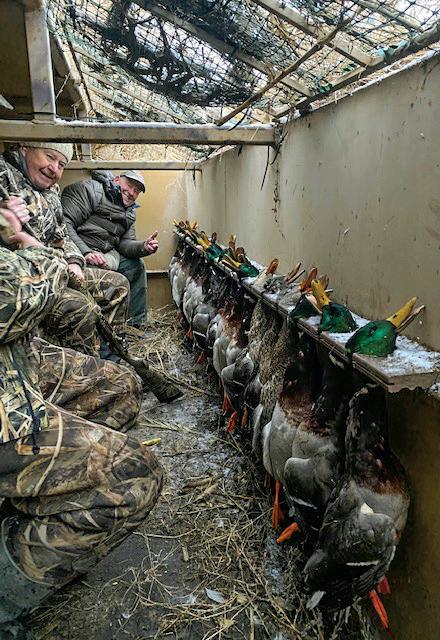

Eastern Washington Tri-Cities • 509-967-2303 • www.pacific-wings.net See our videos on YouTube @ PacificWingsHunting and Jay Goble
